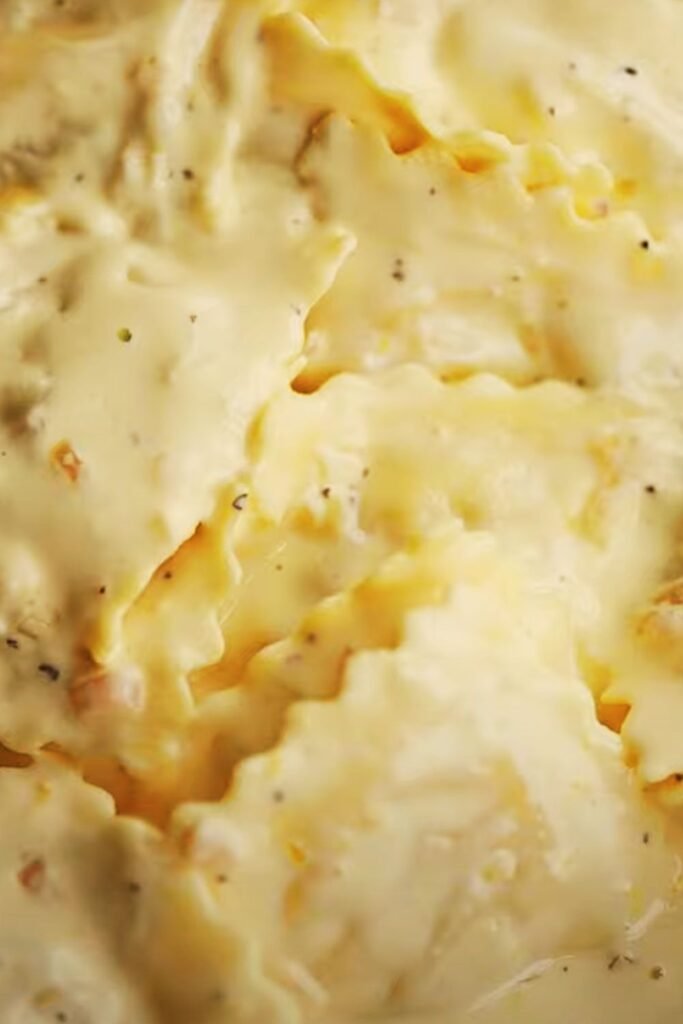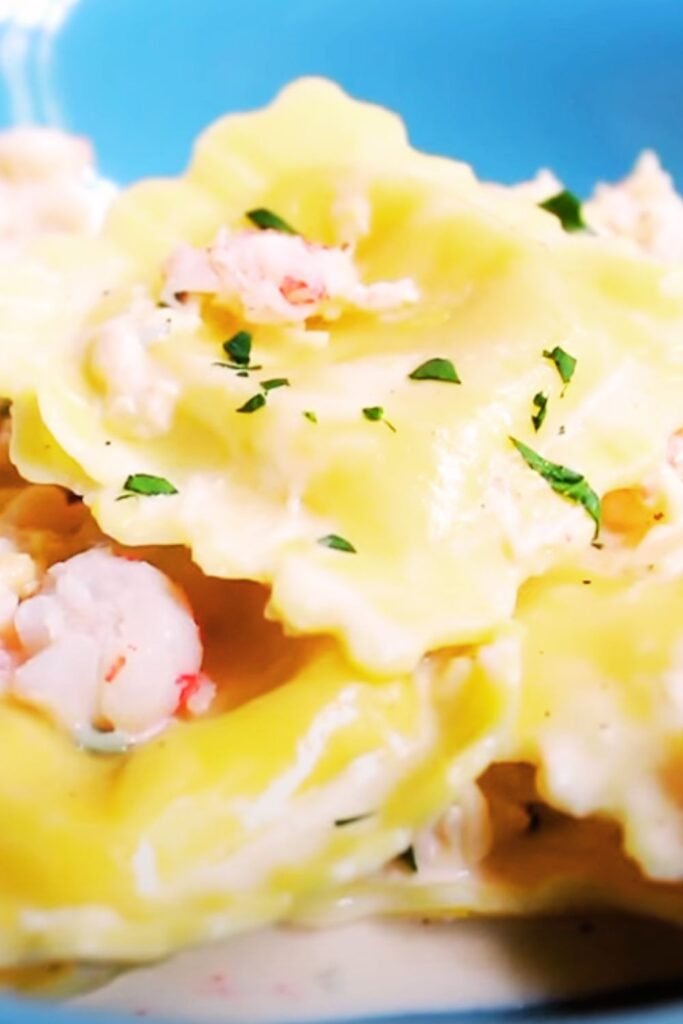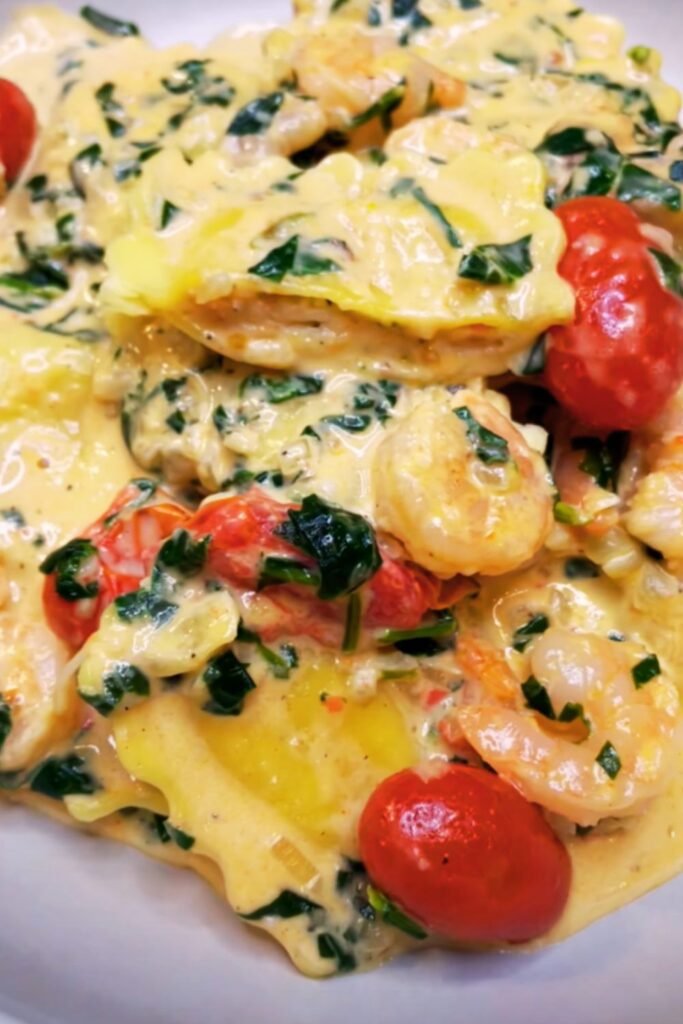There’s something truly magical about serving homemade lobster ravioli during the Christmas season. I’ve been perfecting this recipe for years, and I can honestly say it never fails to impress my guests. The combination of tender lobster meat encased in silky pasta, paired with a luxurious creamy lemon sauce, creates an unforgettable dining experience that elevates any holiday gathering.
Christmas calls for recipes that feel special, and this lobster ravioli delivers exactly that. I love how the bright, citrusy notes of the lemon sauce complement the sweet, delicate flavor of the lobster, while the homemade pasta adds that personal touch that makes the meal truly memorable. Whether you’re hosting an intimate Christmas Eve dinner or preparing a show-stopping course for Christmas Day, this recipe will become your go-to for creating those precious holiday memories.
Understanding the Components
Lobster Selection and Preparation
Fresh Lobster: Live lobsters weighing 1.5-2 pounds each provide the best meat quality and flavor for ravioli filling Frozen Lobster Tails: A convenient alternative that works well when fresh lobster isn’t available Canned Lobster: While acceptable, fresh or frozen options deliver superior taste and texture Lobster Stock: Made from shells and aromatics, this forms the foundation of our creamy sauce
Pasta Dough Essentials
00 Flour: Italian-milled flour creates the silkiest, most pliable pasta dough Semolina Flour: Adds structure and helps prevent sticking during rolling Fresh Eggs: Room temperature eggs incorporate more easily and create better texture Olive Oil: A small amount adds richness and makes the dough more workable
Sauce Components
Heavy Cream: The base for our luxurious sauce that coats each ravioli perfectly Fresh Lemons: Both zest and juice provide bright acidity that balances the richness White Wine: Adds depth and helps deglaze the pan for maximum flavor Fresh Herbs: Chives and parsley bring color and freshness to the finished dish
Detailed Ingredient Breakdown
| Component | Ingredient | Quantity | Quality Notes |
|---|---|---|---|
| Lobster Filling | Fresh lobster meat | 1.5 lbs | Choose lobsters with active movement |
| Ricotta cheese | 1 cup | Full-fat for creaminess | |
| Mascarpone | 1/2 cup | Room temperature for easy mixing | |
| Fresh chives | 3 tbsp | Finely chopped | |
| Lemon zest | 2 tsp | From 1 large lemon | |
| Salt | 1 tsp | Fine sea salt preferred | |
| White pepper | 1/2 tsp | Freshly ground | |
| Pasta Dough | 00 flour | 2 cups | Sifted for smoothness |
| Semolina flour | 1/2 cup | Adds texture and prevents sticking | |
| Large eggs | 4 whole | Room temperature | |
| Egg yolks | 2 additional | For richness | |
| Olive oil | 2 tbsp | Extra virgin | |
| Salt | 1 tsp | Fine sea salt | |
| Lemon Cream Sauce | Heavy cream | 1.5 cups | 36% fat content ideal |
| Butter | 4 tbsp | European-style preferred | |
| Fresh lemon juice | 1/4 cup | Strained to remove pulp | |
| Lemon zest | 1 tbsp | From 2 lemons | |
| White wine | 1/2 cup | Dry variety like Sauvignon Blanc | |
| Shallots | 2 medium | Finely minced | |
| Garlic | 3 cloves | Fresh, not pre-minced |
Step-by-Step Preparation Process
Preparing the Lobster
I always start with the lobster preparation since it takes the most time and the meat needs to cool completely before making the filling.
First, I bring a large pot of salted water to a rolling boil. The water should taste like seawater – this seasons the lobster meat beautifully. I plunge the live lobsters headfirst into the water and cook them for 8-10 minutes, depending on their size. The shells turn bright red when they’re done.

After cooking, I immediately transfer the lobsters to an ice bath to stop the cooking process. This prevents the meat from becoming tough and rubbery. Once they’re cool enough to handle, I carefully extract all the meat from the tails, claws, and knuckles. I save every shell – these will become the base for my lobster stock, which adds incredible depth to the sauce.
The lobster meat gets chopped into small, bite-sized pieces. I’m careful not to over-chop it because I want some texture in my filling. A rough chop works perfectly, leaving some larger pieces that will provide delightful bursts of lobster flavor in each ravioli.
Making the Perfect Pasta Dough
Creating pasta dough by hand connects you to generations of Italian cooks, and I find the process incredibly meditative. I start by creating a well with the flour mixture on a clean work surface. The well needs to be deep enough to hold all the eggs without them spilling over the sides.
I crack the eggs into the center of the well and add the olive oil. Using a fork, I gradually incorporate the flour from the inner walls of the well, working slowly to prevent the eggs from breaking through. This gradual incorporation creates a smoother, more uniform dough.
Once the mixture becomes too thick for a fork, I switch to using my hands. The dough will seem rough and shaggy at first, but I keep kneading. After about 10 minutes of consistent kneading, the dough transforms into something smooth and elastic. I know it’s ready when I can poke it with my finger and it springs back.
The dough needs to rest for at least 30 minutes, wrapped tightly in plastic wrap. This resting period allows the gluten to relax, making the dough much easier to roll out later.
Creating the Lobster Filling
While the dough rests, I prepare the filling by combining the chopped lobster meat with ricotta, mascarpone, and seasonings. The key here is gentle folding rather than aggressive mixing – I want to keep the lobster pieces intact and avoid making the mixture too dense.
I taste and adjust the seasoning carefully. The filling should be well-seasoned but not overpowering, allowing the sweet lobster flavor to shine through. The lemon zest adds brightness, while the white pepper provides warmth without the visual specks that black pepper would leave.
| Filling Ratios | Amount | Purpose |
|---|---|---|
| Lobster meat | 60% | Primary flavor component |
| Ricotta | 25% | Creamy base and moisture |
| Mascarpone | 10% | Rich texture and binding |
| Seasonings | 5% | Flavor enhancement |
Rolling and Shaping the Ravioli

I divide my rested dough into four portions, keeping the pieces I’m not immediately using covered with plastic wrap. Working with one piece at a time, I roll the dough through my pasta machine, starting at the widest setting and gradually working down to setting number 6. The sheets should be thin enough that you can almost see through them, but not so thin that they tear easily.
For perfectly shaped ravioli, I use a ravioli mold or simply cut squares with a knife. I place small dollops of filling (about 1 tablespoon each) on one pasta sheet, leaving adequate space between each portion. I brush the areas around the filling with water – this acts as glue to seal the ravioli.
I carefully lay the second pasta sheet over the filling and press around each mound to eliminate air bubbles and seal the edges. Air bubbles are the enemy of good ravioli because they can cause the pasta to burst during cooking.
Using a fluted pasta wheel or sharp knife, I cut between the sealed mounds to create individual ravioli. Each one gets placed on a floured baking sheet, ensuring they don’t touch each other to prevent sticking.
Crafting the Creamy Lemon Sauce
The sauce comes together quickly, so I prepare it while the ravioli water is heating. I start by sautéing minced shallots and garlic in butter until they’re fragrant and translucent, being careful not to let them brown.
I add the white wine and let it reduce by half, which concentrates the flavor and cooks out the alcohol. Then I pour in the heavy cream and bring it to a gentle simmer. The sauce should never boil vigorously, as this can cause it to break or curdle.
I add the lemon juice and zest gradually, tasting as I go. The sauce should have a bright, citrusy flavor that complements rather than overpowers the delicate lobster. I finish with a pat of cold butter, which gives the sauce a beautiful glossy finish and rich mouthfeel.
Cooking and Assembly Techniques
Proper Ravioli Cooking Method
I bring a large pot of well-salted water to a gentle boil. The water should have enough room for the ravioli to move freely without crowding. I carefully lower each raviolo into the water using a slotted spoon to prevent them from sticking to the bottom of the pot.
Fresh ravioli cook quickly – usually just 3-4 minutes until they float to the surface. I taste one to ensure the pasta is al dente. Overcooking will make the delicate pasta mushy and can cause the filling to leak out.
Timing and Service Coordination
Timing is crucial for this dish. I have my sauce warming gently on low heat while the ravioli cook. As soon as the ravioli are done, I transfer them directly to the sauce using a slotted spoon, bringing a little pasta water with them. This starchy water helps the sauce cling to the pasta beautifully.
I gently toss the ravioli in the sauce, adding fresh herbs at the last moment to preserve their bright color and flavor. The entire assembly process should take no more than 2-3 minutes to ensure everything stays hot for service.
Presentation and Serving Suggestions
Plating for Maximum Impact
I warm my serving plates in a low oven before plating – hot plates keep the dish at the perfect temperature longer. I arrange 4-5 ravioli per plate in an overlapping pattern, then spoon the creamy lemon sauce over and around them.
A final sprinkle of fresh chives, a few drops of good olive oil, and a light dusting of freshly grated Parmigiano-Reggiano create a restaurant-quality presentation. I like to add a small lemon wedge on the side for those who want an extra burst of citrus.

Christmas Table Integration
This dish works beautifully as either an elegant first course or a sophisticated main dish for Christmas dinner. When serving as an appetizer, I reduce the portion to 3 ravioli per person. As a main course, 6-7 pieces with a side of simply dressed arugula creates a complete and satisfying meal.
The colors – the golden pasta, creamy white sauce, and fresh green herbs – fit perfectly with traditional Christmas color schemes. I often garnish with a sprig of fresh rosemary or thyme to echo Christmas tree aromas.
Accompaniment Options
A light, crisp salad with lemon vinaigrette provides a refreshing contrast to the rich ravioli. I particularly enjoy serving this with:
- Baby arugula dressed with lemon and olive oil
- Roasted asparagus with garlic and almonds
- Simple roasted Brussels sprouts with pancetta
- Crusty Italian bread for sopping up the delicious sauce
Advanced Tips and Troubleshooting
Storage and Make-Ahead Strategies
| Storage Method | Duration | Quality Notes |
|---|---|---|
| Refrigerated (uncooked) | 24 hours | Place on floured trays, cover with plastic |
| Frozen (uncooked) | 3 months | Flash freeze on trays, then bag |
| Cooked and sauced | Not recommended | Pasta becomes mushy upon reheating |
I often make the ravioli a day ahead and store them in the refrigerator. They actually improve slightly overnight as the flavors meld. For longer storage, I freeze them on baking sheets, then transfer to freezer bags once solid.
Common Mistakes and Solutions
Filling too wet: This causes the ravioli to burst during cooking. I always drain ricotta in a fine-mesh strainer for 30 minutes before using, and I avoid adding too much liquid to the filling.
Dough too thick: Thick pasta overwhelms the delicate filling. I always roll to at least setting 6 on my pasta machine, sometimes even thinner for particularly delicate results.
Sauce breaking: This happens when the heat is too high or acid is added too quickly. I always keep the heat low and add lemon juice gradually while whisking constantly.
Professional Finishing Techniques
I’ve learned several tricks from restaurant kitchens that elevate this dish:
- Mount the sauce with cold butter at the end for glossy richness
- Reserve some pasta cooking water to adjust sauce consistency
- Taste and adjust seasoning just before serving – flavors can mellow as the sauce sits
- Use a microplane for the finest lemon zest that distributes evenly throughout
Nutritional Considerations and Dietary Modifications
Nutritional Profile
This dish provides high-quality protein from the lobster and eggs, while the cream sauce adds calcium and vitamin D. A typical serving contains approximately:
- 485 calories per serving (5 ravioli)
- 28g protein from lobster and eggs
- 15g carbohydrates from pasta
- 35g fat from cream, cheese, and egg yolks
Dietary Adaptations
For those with dietary restrictions, I’ve successfully modified this recipe:
Lighter version: I substitute half the heavy cream with whole milk and add a cornstarch slurry for thickness. The flavor remains excellent while reducing calories significantly.
Gluten-free option: Using a blend of rice flour and tapioca starch creates surprisingly good gluten-free pasta, though it requires more careful handling.
Seasonal Variations and Creative Adaptations
Holiday Flavor Variations
During Christmas season, I sometimes add subtle seasonal touches:
- A pinch of fresh thyme in the filling echoes Christmas herb flavors
- A tiny amount of white truffle oil in the sauce for ultimate luxury
- Crispy pancetta crumbles as garnish for textural contrast
- Toasted pine nuts for Mediterranean Christmas flair
Regional Inspirations
I’ve adapted this base recipe with influences from different coastal regions:
New England style: Adding a touch of Old Bay seasoning to the filling Mediterranean version: Including sun-dried tomatoes and fresh basil Asian fusion: Incorporating ginger and a touch of soy sauce in the filling
Q&A Section
Q: Can I make the ravioli ahead of time for a Christmas dinner party?
Yes, absolutely! I recommend making them the day before and storing them covered in the refrigerator. You can also freeze them up to three months ahead. If frozen, cook them directly from frozen – just add an extra minute or two to the cooking time.
Q: What’s the best way to ensure my ravioli don’t burst during cooking?
The key is proper sealing and not overstuffing. I press firmly around each filling mound to eliminate air bubbles, and I only use about 1 tablespoon of filling per ravioli. Also, maintain a gentle boil rather than a rolling boil when cooking.
Q: Can I substitute the mascarpone in the filling?
You can use cream cheese softened to room temperature, though the flavor will be slightly tangier. For a lighter option, I sometimes use Greek yogurt, but drain it well first to prevent the filling from becoming too wet.
Q: How do I prevent the lemon sauce from curdling?
Keep the heat low and add the lemon juice gradually while whisking constantly. If it does start to curdle, remove it from heat immediately and whisk in a tablespoon of cold cream to bring it back together.
Q: What should I do if I don’t have a pasta machine?
You can absolutely roll the dough by hand with a rolling pin. It takes more effort and time, but the results are just as delicious. Roll the dough as thin as possible – you should be able to see your hand through it when held up to the light.
Q: Can I use frozen lobster tails instead of whole lobsters?
Yes, frozen lobster tails work well. Thaw them completely in the refrigerator overnight, then steam or boil them until the meat is opaque. You’ll need about 1.5 pounds of tail meat for this recipe.
Q: How can I tell if my pasta dough has been kneaded enough?
The dough should feel smooth and elastic, not sticky or rough. When you poke it with your finger, it should spring back. This usually takes about 10 minutes of consistent kneading by hand.
Q: What wine pairs best with this dish if I want to serve alcohol to guests?
A crisp white wine like Sauvignon Blanc, Pinot Grigio, or Champagne complements the lobster beautifully without overwhelming the delicate flavors. The acidity in these wines balances the richness of the cream sauce perfectly.
This lobster ravioli recipe has become one of my most requested dishes for special occasions, and I hope it brings the same joy to your Christmas table that it has brought to mine. The combination of homemade pasta, sweet lobster, and bright lemon cream creates a dish that’s both elegant and comforting – exactly what I want to share with loved ones during the holiday season.